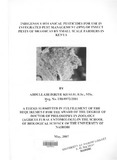| dc.contributor.author | Khalif, Abdullahi D | |
| dc.date.accessioned | 2013-05-23T06:21:40Z | |
| dc.date.available | 2013-05-23T06:21:40Z | |
| dc.date.issued | 2007 | |
| dc.identifier.uri | http://erepository.uonbi.ac.ke:8080/xmlui/handle/123456789/24579 | |
| dc.description.abstract | A survey of the knowledge of indigenous farmers in the selected locations of Kiambu,
Maragua and Machakos districts in Central and Eastern Provinces of Kenya was carried
out to determine their understanding of practical aspects of crop pest management
procedures and methods. To test the insecticidal efficacy of the syrup concentrations
made from the African marigold plant (Tagetes eracta) and of the chilli plant (Capsicum
frutscens) on the diamondback moth (DBM) (Plutella xylostella L.) and the cabbage
aphids (Brevicoryne brassicae L.), quantities of 300g/1 and 50g/1 fresh aqueous extracts
of these plants were prepared in a laboratory and sprayed after 24 hours in kale crop
fields against the DBM and aphids. Field experiments to determine the effects of reduced
frequency use of chemical insecticides were also carried out alternating with chilli
aqueous extracts to determine the effect of reduced use of chemicals by 50 percent on
crop yields. Laboratory experiments to determine best dose of chili freeze-dried extracts
were carried out by testing various concentrations of chili aqueous extracts for their
efficacy against the laboratory reared 3rd instars DBM larvae. Antifeedant effects of the
extracts were assessed by introducing DBM larvae on a treated food (leaf). It was found
that the farmers in the districts studied had time-tested and in-depth knowledge in
farming practices and pest control strategies but lacked knowledge on modern (chemical)
insect pest control issues. Repellent effects and insecticidal properties of liquid
concentrations of the African marigold plant (Tagetes eracta) and of the chilli plant
(Capsicum futscens) on diamondback moth (DBM) (Plutella xylostella L.) larvae and
cabbage aphids (Brevicoryne brassicae L.) were observed. The field experiments
revealed that both DBM larval intensity and cabbage aphids' scores were significant
between the treatments. The effects of the treatments on the actual crop yields varied.
Results from replicate experiments showed significant differences in yields between the
treatments. Treatments with marigold had a negative impact on the kale leaves in that all
the plots sprayed with marigold syrup showed leaf scorching which could have
contributed to less crop yield compared to all the other treatments. It was also observed
that these botanicals had no impact on the natural enemies of the insect pests and on
diseases such as virus and bacterial black rot. Results from the second field experiment
for the reduction of the frequency use of diazinon showed that differences in the
harvested leaves from the weekly sprayed plots with chemicals were not significantly
different from those of the plots sprayed with chemical one week and alternated with
chilli in the following week. Drastic reduction of food intake of the insect pests in the
laboratory experiment was observed as concentration increased. Repellent effects of the
chilli extracts were particularly significant as the concentration increased. However,
larval mortality was not significant but it was proportional with the increment of the
extract concentration. The combination of repellent effects, antifeedant and stomach
poisoning of the chilli extract would make chilli products an alternative strategy on the
vegetable insect pest control and could reduce the frequency use of chemicals for
environmental safety | en |
| dc.description.sponsorship | The University of Nairobi | en |
| dc.language.iso | en | en |
| dc.subject | Indigenous botanical pesticides for use in integrated pest management (IPM) | en |
| dc.subject | insect Pests of brassicas | en |
| dc.title | Indigenous botanical pesticides for use in integrated pest management (IPM) of insect Pests of brassicas by small scale farmers in Kenya | en |
| dc.type | Thesis | en |
| local.publisher | School of biological science | en |

